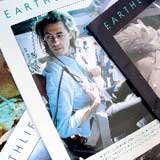
From 1984 to 1986, John edited Earthlife
News.
Links
The wave diagram
Wave
1
Downwave 1
Wave 2
Downwave 2
Wave 3
Downwave 3
www
Julia
Hailes
Timelines
Downwave 1 Wake up to business and markets

From 1984 to 1986, John edited Earthlife
News.
Links
The wave diagram
Wave
1
Downwave 1
Wave 2
Downwave 2
Wave 3
Downwave 3
www
Julia
Hailes
In the late summer of 1974, I joined Transport & Environment Studies (TEST), a small environmental consultancy founded by architect-planner John Roberts. Based in London's Covent Garden, TEST did a wide range of work on improving the pedestrian's environment, the routeing of heavy lorries, the transfer of goods traffic from road to rail, and environmental impact assessment (EIA).
This last area took me to Egypt in 1975, to supervise EIAs being carried out as part of the reconstruction of the Ismailia region after the 1973 Arab-Israeli war. Partway through the project, concerned about the way that environmental issues were being ignored by various agencies of the Egyptian government, I wrote a feature article on the issues for New Scientist ('Beware the Wrath of Osiris'). This led to four years of fairly continuous contributions to the magazine, while I continued working at TEST.
On the domestic front, in 1975 we bought a ruinous house in Barnes, London, which took 3-4 years to redo and which served (both during repairs and after) as an incubator for two children and two businesses.
Elaine left Wildwood House in 1977 and our first daughter, Gaia, was born in July 1977; Hania followed in July 1979. From that point on, Elaine managed the home front - with both John Elkington Associates and later, at least in its early years, SustainAbility playing cuckoos in the family nest.
In 1978, largely as a result of the New Scientist writing, which had started to look at what companies like English China Clays and British Gas were doing on the environmental front, I was approached by Max Nicholson (one of the great figures of what he himself dubbed the "environmental revolution") and David Layton, founder of Incomes Data Services (IDS), to set up a new organisation, Environmental Data Services (ENDS) - and to become the founder-editor of The ENDS Report. After carrying out a feasibility study, I joined up, with the first ENDS office being in Great Smith Street, Westminster.
My first book, The Ecology of Tomorrow's World, was published in 1980 and shortly afterwards I took over as managing director of ENDS, a role I continued in until 1983.
In 1981, Elaine and I travelled around the US on a Winston Churchill Fellowship, gathering much of the material that went into 1984's book, Sun Traps. In 1983, we decided to go freelance, founding John Elkington Associates (JEA). I also started a 15-year run as editor of Biotechnology Bulletin in 1983.
Meanwhile JEA, with the help of people like Nancy Davies and Jonathan Shopley (who now heads Future Forests), did consultancy work for a wide range of clients, among them BP, British Gas, the Design Council (working on the Green Designer exhibition in 1986, during which I first came up with the term 'green consumer'), the Nature Conservancy Council, the OECD and the US Agency for International Development (AID).
Further books appeared, among them The Gene Factory and The Poisoned Womb. As far as other forms of journalism went, I had written my first article for The Guardian in 1979, which would be followed by two decades of columns, written for various different parts of the paper, including 'Futures', 'Lifestyles', and 'Jobs & Money'.
Simultaneously, I was getting involved in the activities of the Earthlife Foundation. I edited Earthlife News for several years and began work on Green Pages. It was during this period that I met Julia Hailes. She joined to help manage the Green Pages project and, when Earthlife collapsed in early 1987, we co-founded SustainAbility - with early help from Tom Burke, then director of the Green Alliance.
1987 saw the publication of The Green Capitalists. Two
years before the collapse of the Berlin Wall, the book (with a concluding
chapter by Tom) argued that those interested in environment and sustainable
development would have to learn to work with business, through markets, if
they wanted to make real progress. In many ways, the book sketched out our
agenda for the next 15 years.